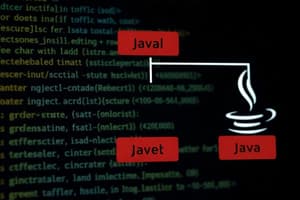Podcast
Questions and Answers
The process of inheritance should establish a(n) ________ relationship.
The process of inheritance should establish a(n) ________ relationship.
IS-A
The original class that is used to derive a new class using inheritance is called _________.
The original class that is used to derive a new class using inheritance is called _________.
All of the above (A superclass, parent class, and a base class)
In order for derived classes to have access to encapsulated data members and methods of superclasses, the data members and methods should be declared using the ___________ modifier.
In order for derived classes to have access to encapsulated data members and methods of superclasses, the data members and methods should be declared using the ___________ modifier.
protected
The special reference ________ is used to refer to the parent class in a child class.
The special reference ________ is used to refer to the parent class in a child class.
When a variable is declared in a subclass and has the same name as a variable declared in a superclass, it is called a ________ variable.
When a variable is declared in a subclass and has the same name as a variable declared in a superclass, it is called a ________ variable.
Which of the following keywords indicates a new class is being derived from an existing class?
Which of the following keywords indicates a new class is being derived from an existing class?
All Java classes are subclasses of the __________ class.
All Java classes are subclasses of the __________ class.
Of the classes below, the one that is most likely to be declared 'abstract' is ____________.
Of the classes below, the one that is most likely to be declared 'abstract' is ____________.
In Java, subclasses can only 'extend' one parent class.
In Java, subclasses can only 'extend' one parent class.
An abstract class must contain abstract methods.
An abstract class must contain abstract methods.
A child class is not allowed to define a method with the same name and parameter list as a method in the parent class.
A child class is not allowed to define a method with the same name and parameter list as a method in the parent class.
A class declared 'final' cannot be used as a basis for inheritance.
A class declared 'final' cannot be used as a basis for inheritance.
Describe the relationship between a parent class and a child class.
Describe the relationship between a parent class and a child class.
What does the protected modifier accomplish?
What does the protected modifier accomplish?
Why is the super reference important to a child class?
Why is the super reference important to a child class?
What is the difference between single inheritance and multiple inheritance?
What is the difference between single inheritance and multiple inheritance?
Why would a child class override one or more of the methods of its parent class?
Why would a child class override one or more of the methods of its parent class?
What is the role of an abstract class?
What is the role of an abstract class?
Can you inherit from multiple classes or implement multiple interfaces?
Can you inherit from multiple classes or implement multiple interfaces?
Flashcards are hidden until you start studying
Study Notes
Inheritance Concepts
- Inheritance establishes an IS-A relationship between derived and base classes.
- The class from which a new class is derived is known as a superclass, parent class, or base class.
Access Modifiers
- The Protected modifier allows derived classes to access encapsulated data and methods in superclasses.
Special References
- The "super" reference is used in a child class to refer to its parent class.
Variable Shadowing
- A variable declared in a subclass with the same name as a variable in the superclass is called a shadow variable.
Class Derivation
- The keyword "extends" indicates that a new class is derived from an existing class.
Base Class
- All Java classes inherit from the Object class, which serves as the root of the class hierarchy.
Abstract Classes
- The class most likely to be declared abstract in a hierarchy is generally a base class like "Animal".
Inheritance Limitations
- Java allows subclasses to extend only one parent class, indicating single inheritance.
- An abstract class is not required to contain abstract methods.
Method Overriding
- A child class can define a method with the same name and parameters as a parent class method, contrary to improper assumptions.
Final Classes
- Classes declared as "final" cannot serve as a parent class for inheritance, preventing further extension.
Protected Modifier Effect
- The protected modifier enables access to members from any class within the same package.
Constructor Calls
- The super reference is critical in a child class for invoking the parent class's constructor.
Differences in Inheritance Types
- Java supports single inheritance to avoid property clashes, while multiple inheritance is disallowed.
Method Redefinition
- A child class may override parent class methods to customize behavior and provide its own specific implementations.
Role of Abstract Classes
- Abstract classes serve as general concepts that facilitate the creation of child classes through extensions.
Interface Implementation
- Java prohibits multiple class inheritance but allows a class to implement multiple interfaces, differentiating between classes and interfaces.
Studying That Suits You
Use AI to generate personalized quizzes and flashcards to suit your learning preferences.




